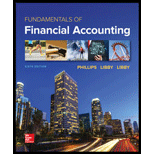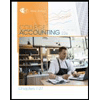
Loose Leaf For Fundamentals Of Financial Accounting
6th Edition
ISBN: 9781260159547
Author: Phillips Associate Professor, Fred, Libby, Robert, Patricia
Publisher: McGraw-Hill Education
expand_more
expand_more
format_list_bulleted
Textbook Question
Chapter 13, Problem 7E
Computing and Interpreting Selected
Double West Suppliers (DWS) reported sales for the year of $300,000, all on credit. The average gross profit percentage was 40 percent on sales. Account balances follow:
| Beginning | Ending | |
| $45,000 | $55,000 | |
| Inventory | 60,000 | 40,000 |
Required:
- 1. Compute the turnover ratios for accounts receivable and inventory (round to one decimal place).
- 2. By dividing 365 by your ratios from requirement 1, calculate the average days to collect receivables and the average days to sell inventory (round to one decimal place).
- 3. Explain what each of these ratios and measures means for DWS.
Expert Solution & Answer
Want to see the full answer?
Check out a sample textbook solution
Students have asked these similar questions
Scarce resource; discontinued product lines; negative contribution marginThe officers of Bardwell Company are reviewing the profitability of the company’s four products and the potential effects of several proposals for varying the product mix. The following is an excerpt from the income statement and other data.
Total
Product P
Product Q
Product R
Product S
Sales
$62,600
$10,000
$18,000
$12,600
$22,000
Cost of goods sold
(44,274)
(4,750)
(7,056)
(13,968)
(18,500)
Gross profit
$18,326
$5,250
$10,944
$(1,368)
$3,500
Operating expenses
(12,004)
(1,990)
(2,968)
(2,826)
(4,220)
Income before taxes
6,322
$3,260
$7,976
$(4,194)
$(720)
Units sold
1,000
1,200
1,800
2,000
Sales price per unit
$10.00
$15.00
$7.00
$11.00
Variable cost of goods sold
2.50
3.00
6.50
6.00
Variable operating expenses
1.17
1.25
1.00
1.20
Each of the following proposals is to be considered independently of the other proposals. Consider only the product changes stated in each…
Analyzing one company's make or buy and special order proposals
OneCo is a retail organization in the Northeast that sells upscale clothing. Each year, store managers (in consultation with their supervisors) establish financial goals; a monthly reporting system captures actual performance.
OneCo Inc. produces a single product. Cost per unit, based on the manufacture and sale of 10,000 units per month at full capacity, is shown below.
Product costs
Direct materials
$4.00
Direct labor
1.30
Variable overhead
2.50
Fixed overhead
3.40
Sales commission
0.90
$12.10
The $0.90 sales commission is paid for every unit sold through regular channels. Market demand is such that OneCo is operating at full capacity, and the firm has found it can sell all it can produce at the market price of $16.50.
Currently, OneCo is considering two separate proposals:
· Gatsby, Inc. has offered to buy 1,000 units at $14.35 each. Sales commission would be $0.35 on this special order.
·…
MYS App Ch 1 M Ques M X
Chat Use ta gaut Soluta acco a webs a wear a acco
calcuTelesa Requ
/ezto.mheducation.com/ext/map/index.html?_con=con&external_browser=0&launchUrl=https%253A%252F%252Fconnect.mheducation.com%252Fconnect
ework i
ces
Saved
[The following information applies to the questions displayed below.]
The first production department in a process manufacturing system reports the following unit data.
Beginning work in process inventory
Units started and completed
35,200 units
52,800 units
Units completed and transferred out
Ending work in process inventory
88,000 units
17,900 units
Help
Save &
Exercise 16-4 (Algo) Weighted average: Computing equivalent units LO P1
Prepare the production department's equivalent units of production for direct materials under each of the following three separate
assumptions using the weighted average method for process costing.
Equivalent Units of Production (EUP)-Weighted Average Method
1. All direct materials are added to products when…
Chapter 13 Solutions
Loose Leaf For Fundamentals Of Financial Accounting
Ch. 13 - What is the general goal of trend analysis?Ch. 13 - Prob. 2QCh. 13 - What is ratio analysis? Why is it useful?Ch. 13 - What benchmarks are commonly used for interpreting...Ch. 13 - Prob. 5QCh. 13 - Prob. 6QCh. 13 - Slow Cellars current ratio increased from 1.2 to...Ch. 13 - From last year to this year, Colossal Companys...Ch. 13 - From last year to this year, Berry Bam reported...Ch. 13 - Explain whether the following situations, taken...
Ch. 13 - What are the two essential characteristics of...Ch. 13 - Prob. 12QCh. 13 - Prob. 13QCh. 13 - Prob. 14QCh. 13 - Prob. 15QCh. 13 - Prob. 16QCh. 13 - 1. Which of the following ratios is not used to...Ch. 13 - Prob. 2MCCh. 13 - Prob. 3MCCh. 13 - Analysts use ratios to a. Compare different...Ch. 13 - Which of the following ratios incorporates stock...Ch. 13 - Prob. 6MCCh. 13 - Prob. 7MCCh. 13 - A bank is least likely to use which of the...Ch. 13 - Prob. 9MCCh. 13 - (Supplement 13A) Which of the following items is...Ch. 13 - Calculations for Horizontal Analyses Using the...Ch. 13 - Calculations for Vertical Analyses Refer to M13-1....Ch. 13 - Interpreting Horizontal Analyses Refer to the...Ch. 13 - Interpreting Vertical Analyses Refer to the...Ch. 13 - Prob. 5MECh. 13 - Prob. 6MECh. 13 - Prob. 7MECh. 13 - Analyzing the Inventory Turnover Ratio A...Ch. 13 - Inferring Financial Information Using the Current...Ch. 13 - Prob. 10MECh. 13 - Identifying Relevant Ratios Identify the ratio...Ch. 13 - Prob. 12MECh. 13 - Analyzing the Impact of Accounting Alternatives...Ch. 13 - Describing the Effect of Accounting Decisions on...Ch. 13 - Prob. 1ECh. 13 - Prob. 2ECh. 13 - Prob. 3ECh. 13 - Prob. 4ECh. 13 - Prob. 5ECh. 13 - Matching Each Ratio with Its Computational Formula...Ch. 13 - Computing and Interpreting Selected Liquidity...Ch. 13 - Prob. 8ECh. 13 - Prob. 9ECh. 13 - Prob. 10ECh. 13 - Prob. 11ECh. 13 - Prob. 12ECh. 13 - Prob. 13ECh. 13 - Prob. 14ECh. 13 - Analyzing the Impact of Alternative Inventory...Ch. 13 - Prob. 1CPCh. 13 - Prob. 2CPCh. 13 - Prob. 3CPCh. 13 - Prob. 4CPCh. 13 - Prob. 5CPCh. 13 - Prob. 6CPCh. 13 - Prob. 7CPCh. 13 - Prob. 1PACh. 13 - Prob. 2PACh. 13 - Prob. 3PACh. 13 - Prob. 4PACh. 13 - Prob. 5PACh. 13 - Using Ratios to Compare Loan Requests from Two...Ch. 13 - Prob. 7PACh. 13 - Prob. 1PBCh. 13 - Prob. 2PBCh. 13 - Prob. 3PBCh. 13 - Prob. 4PBCh. 13 - Prob. 5PBCh. 13 - Using Ratios to Compare Loan Requests from Two...Ch. 13 - Prob. 7PBCh. 13 - Prob. 1SDCCh. 13 - Prob. 2SDCCh. 13 - Prob. 5SDCCh. 13 - Prob. 6SDCCh. 13 - Prob. 7SDCCh. 13 - Prob. 1CC
Knowledge Booster
Learn more about
Need a deep-dive on the concept behind this application? Look no further. Learn more about this topic, accounting and related others by exploring similar questions and additional content below.Similar questions
arrow_back_ios
SEE MORE QUESTIONS
arrow_forward_ios
Recommended textbooks for you
 Managerial Accounting: The Cornerstone of Busines...AccountingISBN:9781337115773Author:Maryanne M. Mowen, Don R. Hansen, Dan L. HeitgerPublisher:Cengage Learning
Managerial Accounting: The Cornerstone of Busines...AccountingISBN:9781337115773Author:Maryanne M. Mowen, Don R. Hansen, Dan L. HeitgerPublisher:Cengage Learning College Accounting, Chapters 1-27 (New in Account...AccountingISBN:9781305666160Author:James A. Heintz, Robert W. ParryPublisher:Cengage Learning
College Accounting, Chapters 1-27 (New in Account...AccountingISBN:9781305666160Author:James A. Heintz, Robert W. ParryPublisher:Cengage Learning College Accounting, Chapters 1-27AccountingISBN:9781337794756Author:HEINTZ, James A.Publisher:Cengage Learning,
College Accounting, Chapters 1-27AccountingISBN:9781337794756Author:HEINTZ, James A.Publisher:Cengage Learning, Survey of Accounting (Accounting I)AccountingISBN:9781305961883Author:Carl WarrenPublisher:Cengage Learning
Survey of Accounting (Accounting I)AccountingISBN:9781305961883Author:Carl WarrenPublisher:Cengage Learning Managerial AccountingAccountingISBN:9781337912020Author:Carl Warren, Ph.d. Cma William B. TaylerPublisher:South-Western College Pub
Managerial AccountingAccountingISBN:9781337912020Author:Carl Warren, Ph.d. Cma William B. TaylerPublisher:South-Western College Pub

Managerial Accounting: The Cornerstone of Busines...
Accounting
ISBN:9781337115773
Author:Maryanne M. Mowen, Don R. Hansen, Dan L. Heitger
Publisher:Cengage Learning

College Accounting, Chapters 1-27 (New in Account...
Accounting
ISBN:9781305666160
Author:James A. Heintz, Robert W. Parry
Publisher:Cengage Learning

College Accounting, Chapters 1-27
Accounting
ISBN:9781337794756
Author:HEINTZ, James A.
Publisher:Cengage Learning,

Survey of Accounting (Accounting I)
Accounting
ISBN:9781305961883
Author:Carl Warren
Publisher:Cengage Learning

Managerial Accounting
Accounting
ISBN:9781337912020
Author:Carl Warren, Ph.d. Cma William B. Tayler
Publisher:South-Western College Pub
Financial ratio analysis; Author: The Finance Storyteller;https://www.youtube.com/watch?v=MTq7HuvoGck;License: Standard Youtube License